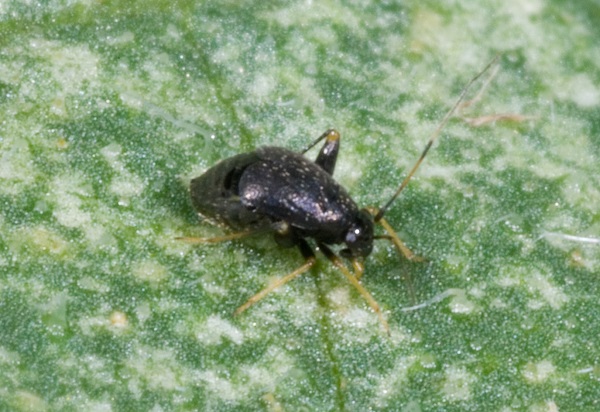Garden Fleahopper
ENTFACT-307: Garden Fleahopper | Download PDF
Ric Bessin, Extension Specialist
University of Kentucky College of Agriculture
Garden fleahopper is a common insect found on various vegetables, weeds, and ornamental plants. Because of their size, shape and movement, fleahoppers are often mistaken for flea beetles. Garden fleahoppers are plant bugs that feed by piercing the leaves with their sucking mouthparts to extract plant sap. Lightly infested leaves will develop pale spots or stippling resembling mite damage, while heavily infested leaves may turn completely pale, dry up, and fall from the plant. Leaf feeding and leaf drop may cause plant stunting and yield loss. Weeds such as quickweed, clover, and morning glory often become heavily infested with garden fleahoppers and constitute a serious source of infestation if allowed to grow near cultivated plants. Garden fleahoppers are found on beans, beet, cabbage, celery, corn, cucumbers, eggplant, lettuce, parsley, peas, peppers, potatoes, squash, sweet potatoes, tomatoes, as well many herbs and other annual plants.

Figure 1. Fleahoppers jump when disturbed and leave damage similar to mite stippling.
Fleahoppers generally resemble black aphids in appearance, but all stages jump readily when disturbed. These insects are frequently mistaken for flea beetles because of their Jumping habit. Unlike flea beetles, which usually jump to a new plant when disturbed, fleahoppers usuaily jump a short distance of only two or three inches. Flea beetles chew small holes in leaves while fleahoppers feed with sucking mouthparts and extract only plant sap.
Nymphs emerge in the spring from the overwintering egg stage. The pale-yellow to light-green nymphs feed on the undersides of leaves for 11 to 41 days before becoming adults. The adults are black and may be of three forms. There is a slender, long winged female form which is about 1/12 inch long and one third a wide as well as a short winged female that is ova! and without transparent tips at the ends of the wings. It is this short winged form which is commonly mistaken for a flea beetle. Males are slender with long wings. All forms have long legs and antennae. Females lay approximately 105 eggs over their 1 to 3 month life span. Eggs are inserted into the stems and leaves of the plants on which the females feed. Eggs hatch 12 to 20 days later.
Fleahoppers are sporadic, but if infestations become severe, insecticides listed in home and/or commercial recommendations for control of aphids should provide adequate control. Because eggs are protected for sprays inside the plant tissue, as second insecticide application may be necessary after egg hatch. Destruction of weedy hosts near cultivated areas will help to prevent this insect from reaching damaging numbers.
Revised: 11/19
CAUTION! Pesticide recommendations in this publication are registered for use in Kentucky, USA ONLY! The use of some products may not be legal in your state or country. Please check with your local county agent or regulatory official before using any pesticide mentioned in this publication.
Of course, ALWAYS READ AND FOLLOW LABEL DIRECTIONS FOR SAFE USE OF ANY PESTICIDE!
Photos courtesy Ric Bessin, University of Kentucky Entomology
